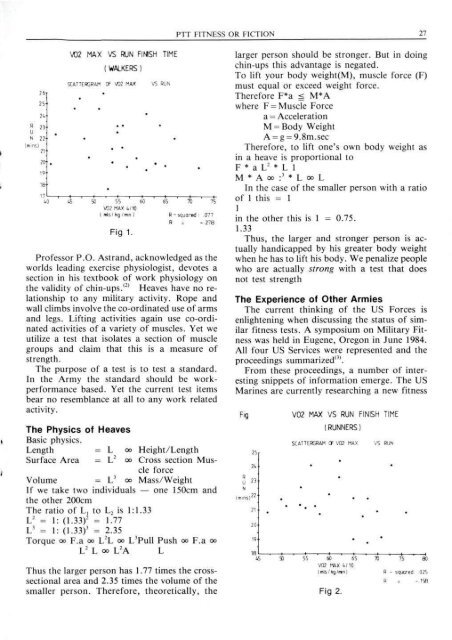ISSUE 70 : May/Jun - 1988 - Australian Defence Force Journal
ISSUE 70 : May/Jun - 1988 - Australian Defence Force Journal
ISSUE 70 : May/Jun - 1988 - Australian Defence Force Journal
Create successful ePaper yourself
Turn your PDF publications into a flip-book with our unique Google optimized e-Paper software.
PTT FITNESS OR FICTION 27<br />
26-t<br />
25'<br />
V.<br />
V02 MAX<br />
VS RUN FINISH TIME<br />
( WALKERS )<br />
SCATTERGRAM Of V02 MAX<br />
R n.<br />
U<br />
'• 22<br />
(mins) .<br />
21-<br />
VS RUN<br />
• ' '<br />
17 I 1 ) 1 1 1 1 1 1 , ( , 1 , 1-<br />
40 US 50 SS 60 65 <strong>70</strong> 75<br />
V02 MAX 4/10<br />
(mts/kg/min) R - squared : .077<br />
R = -.27!)<br />
Fig 1.<br />
Professor P.O. Astrand, acknowledged as the<br />
worlds leading exercise physiologist, devotes a<br />
section in his textbook of work physiology on<br />
the validity of chin-ups.' 2> Heaves have no relationship<br />
to any military activity. Rope and<br />
wall climbs involve the co-ordinated use of arms<br />
and legs. Lifting activities again use co-ordinated<br />
activities of a variety of muscles. Yet we<br />
utilize a test that isolates a section of muscle<br />
groups and claim that this is a measure of<br />
strength.<br />
The purpose of a test is to test a standard.<br />
In the Army the standard should be workperformance<br />
based. Yet the current test items<br />
bear no resemblance at all to any work related<br />
activity.<br />
The Physics of Heaves<br />
Basic physics.<br />
Length = L oo Height/Length<br />
Surface Area = L 2 oo Cross section Muscle<br />
force<br />
Volume = L 3 oo Mass/Weight<br />
If we take two individuals — one 150cm and<br />
the other 200cm<br />
The ratio of L, to L 2 is 1:1.33<br />
V = 1: (1.33) 2 = 1.77<br />
L 3 = 1: (1.33) 3 = 2.35<br />
Torque oo F.a oo L 2 L oo L 3 Pull Push oo F.a oo<br />
L 2 L oo L 2 A L<br />
Thus the larger person has 1.77 times the crosssectional<br />
area and 2.35 times the volume of the<br />
smaller person. Therefore, theoretically, the<br />
larger person should be stronger. But in doing<br />
chin-ups this advantage is negated.<br />
To lift your body weight(M), muscle force (F)<br />
must equal or exceed weight force.<br />
Therefore F*a ^ M*A<br />
where F= Muscle <strong>Force</strong><br />
a = Acceleration<br />
M = Body Weight<br />
A = g = 9.8m.sec<br />
Therefore, to lift one's own body weight as<br />
in a heave is proportional to<br />
F * a L 2 * L 1<br />
M * A oo :' * L oo L<br />
In the case of the smaller person with a ratio<br />
of 1 this = 1<br />
1<br />
in the other this is 1 = 0.75.<br />
1.33<br />
Thus, the larger and stronger person is actually<br />
handicapped by his greater body weight<br />
when he has to lift his body. We penalize people<br />
who are actually strong with a test that does<br />
not test strength<br />
The Experience of Other Armies<br />
The current thinking of the US <strong>Force</strong>s is<br />
enlightening when discussing the status of similar<br />
fitness tests. A symposium on Military Fitness<br />
was held in Eugene, Oregon in <strong>Jun</strong>e 1984.<br />
All four US Services were represented and the<br />
proceedings summarized' 3 '.<br />
From these proceedings, a number of interesting<br />
snippets of information emerge. The US<br />
Marines are currently researching a new fitness<br />
Fig<br />
25r<br />
5 »<br />
N<br />
V02 MAX VS RUN FINISH TIME<br />
(RUNNERS)<br />
SCATTERGRAM OF V02 MAX<br />
??•<br />
•<br />
(mms) • • •<br />
20'<br />
19.- • t '<br />
VS RUN<br />
10 I . » . » . » , » , 1 , ! , 1<br />
45 50 55 60 65 <strong>70</strong> 75 80<br />
V02 MAX 4/10<br />
(mts/kg/mn) R - squared. 025<br />
R = -.158<br />
Fig 2.

















